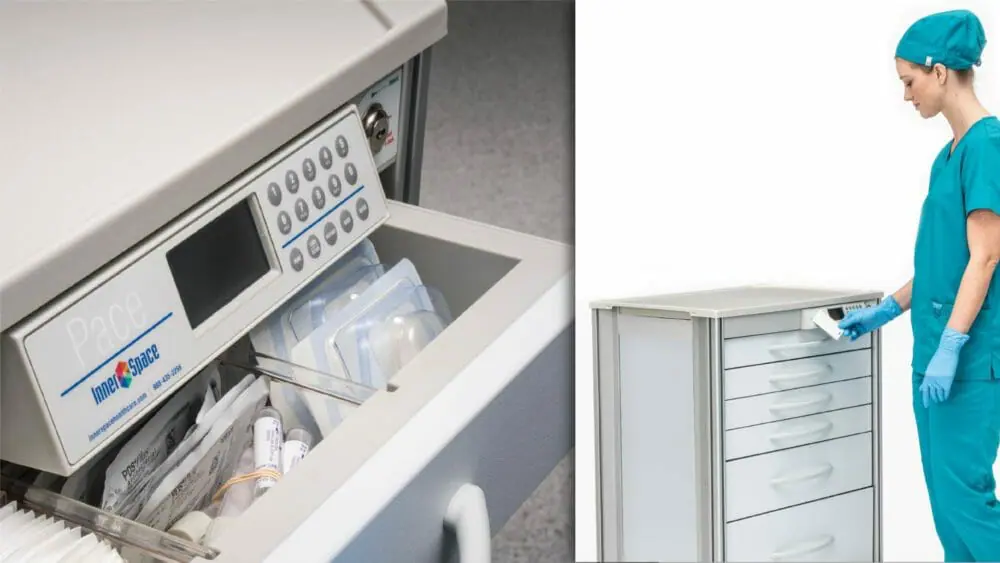
New hospitals are incorporating advanced security measures into their design from the bottom up. Alarm systems to keep patients from wandering, video surveillance cameras, and clear views of entrance areas are all methods used to increase the security of hospitals.
Hospitals are responsible for safeguarding medical equipment, supplies, and medications. Because hospitals operate 24/7 and are revolving doors for staff, patients, and visitors, equipment must be secured in such a way that it is easily accessible to authorized staff but remains unavailable to patients, visitors, and unauthorized staff.
Why Should Medical Supplies Be Secured?
Unauthorized access to and appropriation of medical supplies and medications can impact patients, staff, and the facility’s bottom line. The three main reasons a facility should be diligent about securing its assets are risk of injury, drug diversion, and stolen equipment.
Risk of Injury
Medical supplies are not harmless. The contents of a crash or procedure cart, such as needles, scalpels, and IV tubing, can be used to inflict harm, either accidentally or intentionally. Hospitals may be liable if a patient or visitor is injured due to the failure of staff to keep hospital supplies secured.
Drug Diversion
A review of the literature addressing drug diversion, published in the Journal of Hospital Medicine, noted that failure to secure controlled drugs plays a role in drug diversion. Most facility-based drug diversions involve health care workers, but patients and visitors are also at risk.
Resale of Stolen Medical Equipment
Complex medical equipment in the wrong hands can cause harm or be sold on the black market for illegal profit.
A U.S. Attorney’s Office press release reported on the indictment of three men who conspired to steal medical supplies from a hospital where two of the men were employed. The cystoscopes, ophthalmoscopes, and otoscopes were resold over the internet.
Which Hospital Departments Need Better Security?
Hospital departments with higher patient acuity levels and continuous foot traffic are more at risk for security issues. These departments include behavioral health units, emergency departments, operating rooms, intensive care units, pediatric and neonatal units, and pharmacies. Let’s look at why these areas may require a stronger focus on security.
Emergency Departments and Behavioral Health Units
Emotions can run high in emergency departments and behavioral health units. Security risks drive the design of these areas, focusing on the safety of staff and patients. Treating people with behavioral health diagnoses and drug addictions requires enhanced security of medications and medical supplies.
Operating Rooms and Intensive Care Units
Operating rooms and intensive care units are scenes of frequent life-saving measures. Staff require easy access to supplies and medications. The ability to access supplies quickly must be balanced with keeping supplies out of the hands of visitors who may pass by open carts or cabinets.
Pediatric Units
Pediatric and neonatal units offer additional security to deter child abductions or domestic altercations. These units typically offer 24-hour a day visitation for family members and should consider higher level security for medications and supplies.
Hospital Pharmacies
Hospital pharmacies that supply medications 24 hours a day, including controlled drugs, require enhanced vigilance to prevent unauthorized medication access by staff and visitors.
The Joint Commission Guidelines
Healthcare organizations and regulating bodies continue to update their guidelines for improving the safety and security of healthcare facilities.
The Joint Commission, a non-profit organization that accredits health care facilities, requires that medications be secured to prevent theft but also requests that facilities consider each unit’s purpose when choosing a method of securing medications. Breakaway locks are appropriate in areas that depend on quick access to life-saving supplies, such as the emergency department and critical care units. However, the facility must employ a system that detects a broken lock and requires prompt restocking and securing of the cart or cabinet.
How High Tech Locking Systems Can Contribute to the Security of Hospital Assets
Keys can be lost, borrowed, and copied. While keypad locks may seem to be a more secure solution, a common code may be shared and misused by unauthorized staff and doesn’t offer traceability.
High-tech locks provide better security and tracking features. Automated locking systems are available that increase security in high-risk areas by:
- Requiring a PIN or a badge swipe, or both, to gain access to the cart or cabinet
- Providing traceability of users and the time each user spends in the cart
- Providing the ability to set up automatic relocks after a set period of inactivity
Adding a digital WIFI platform allows a manager to oversee, track, and update locks and users from a central computer. A WIFI platform can alert the user to carts with low battery or loss of WIFI connection. The platform can also track individual user activity across all connected carts and cabinets, reducing the risk of drug diversion.
Security in healthcare facilities continues to be a concern for hospital administrators, staff, and patients. A comprehensive risk analysis of each department can help managers determine the appropriate security measures for their unit. When it comes to securing drugs and supplies, choosing high-tech locking systems for high-risk units can provide peace of mind for unit managers and hospital administrators.

Cindy Blye
Content WriterCindy Blye, BSN, RN, CCM is a Registered Nurse and Certified Case Manager. She is an Alumni of West Virginia University School of Nursing (BSN), and a member of the Association of Health Care Journalists and The Authors Guild.
